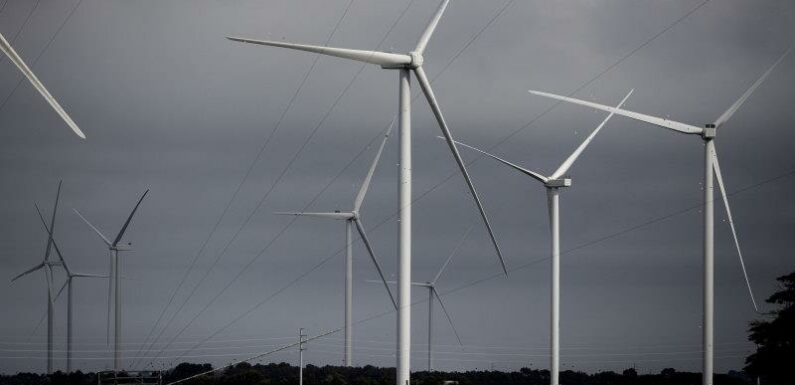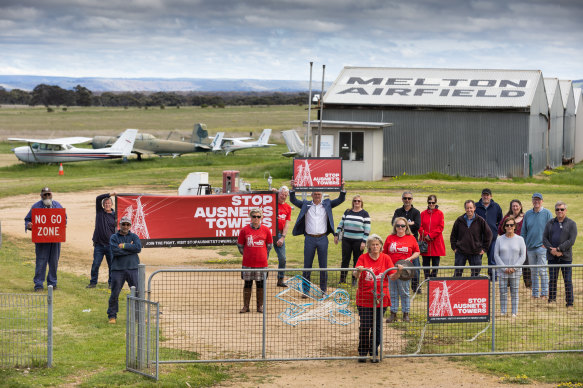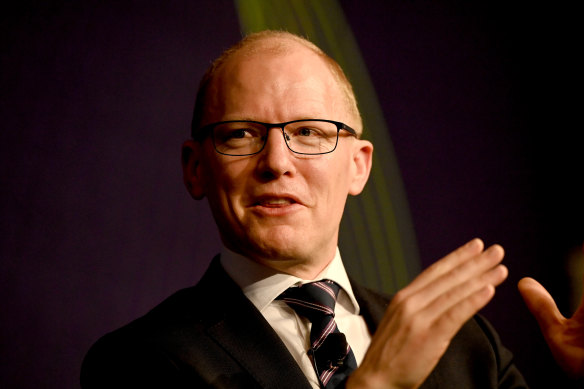
Victorian landholders forced to accept massive electricity transmission lines across their properties will be paid $8000 per kilometre per year for 25 years, as the Andrews government ramps up efforts to soften community concerns.
The scheme, to be announced on Friday, follows warnings that hundreds of kilometres of new high-voltage, high-capacity, power lines will be needed to cope with the supply variations of wind and solar energy. These renewable technologies are coming online as we approach the looming closure of the state’s three remaining coal-fired power stations.
A protest against proposed power lines on the outskirts of Melton during last year’s state election campaign.Credit:Jason South
Energy Minister Lily D’Ambrosio said the first payments under the new compensation scheme would go to landholders who host transmission easements along the proposed VNI West and Western Renewables Link transmission corridors. Victorian landholders affected by the Marinus Link to Tasmania will also be eligible.
It is unclear how many kilometres of power lines will be the subject of compensation, as the exact route of the VNI West link is not yet finalised. But the plan is likely to cost less than $4 million a year, and is expected to add just 55¢ to annual household power bills.
The grid upgrade, however, is almost certain to prove controversial, as some regional communities caught in the path of big transmission projects are already preparing to fight the prospect of long stretches of large above-ground cables hanging from towers looming to 85 metres in height.
The $3.3 billion VNI West project, also known as KerangLink, will involve about 450 kilometres of high-voltage transmission lines, connecting Victoria’s Western Renewables Link (potentially at a terminal just north of Ballarat) with a new interconnector at Dinawan, in the NSW Riverina region, via new stations near Bendigo and Kerang. About 240 kilometres of the link will be in Victoria.
The project will mean power stored by the Snowy 2.0 hydropower scheme in the Snowy Mountains can be sent south to Victoria, while power generated by Victoria’s wind farms can be sent north, and improve the overall stability of the east coast grid.
The 174-kilometre Western Renewables Link, designed to carry energy from wind and solar farms in western Victoria, will start at Bulgana, near Stawell, and connect to Sydenham in Melbourne’s north-west, via a new terminal north of Ballarat.
The three projects, including a 90-kilometre easement on Victorian land for the Marinus Link to Tasmania, will involve a total of 504 kilometres of new transmission lines in Victoria.
D’Ambrosio, who is meeting with state, territory and federal energy ministers in the NSW Hunter region on Friday, said the plan would mean “an equitable approach” for projects spanning the Victorian-NSW border.
Victorian Energy Minister Lily D’Ambrosio.Credit:Elke Meitzel
“These new payments acknowledge the hugely important role landholders play in hosting critical energy infrastructure – a key part of Victoria’s renewables revolution,” D’Ambrosio said.
“We want to get the process for planning and approving new infrastructure right, so we can make sure the renewables revolution is a shared, equitable legacy for all Victorians.”
The state government this week also announced it has given the Australian Energy Market Operator (AEMO) the green light to start early planning work on the VNI West link, which is expected to unlock between 1900 and 5000 megawatts of renewable energy.
The move, which will bring planning work for the project forward by about a year, follows warnings from the AEMO that Victorian households and businesses will face electricity reliability gaps as early as 2024, with minimum reliability standards expected to be breached in Victoria from 2028, as shortages of gas potentially collide with the closure of coal-fired plants.
Daniel Westerman, chief executive of the Australian Energy Market Operator.Credit:Jeremy Piper
The AEMO has become increasingly vocal about the need for thousands of kilometres of new transmission infrastructure to strengthen the reliability of the grid, as the Andrews government has promised to be 65 per cent reliant on renewable energy by 2030 and 95 per cent reliant by 2035.
But the push will also be politically tricky.
AEMO chief executive Daniel Westerman warned in a recent speech that without “social licence”, crucial electricity infrastructure might never get built.
“No one likes to feel railroaded,” he said.
“If we … don’t get this right, infrastructure will cost more, take longer to build, and ultimately may never be completed.”
The issue is already a flash point in regional and outer suburban communities. During last year’s state election, a group of angry farmers and landowners in the seat of Melton, on Melbourne’s outer western fringe, campaigned for the high voltage to be used in the western renewables project to run underground, and warned the government hadn’t taken its concerns seriously.
The Morning Edition newsletter is our guide to the day’s most important and interesting stories, analysis and insights. Sign up here.
Most Viewed in National
From our partners
Source: Read Full Article


